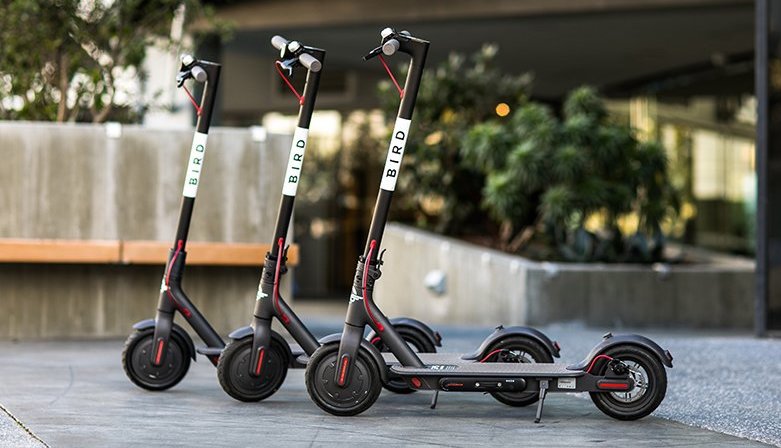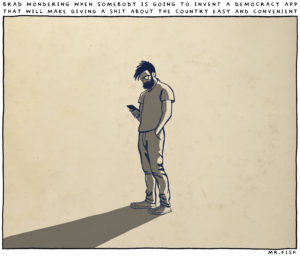E-Scooters Are Giving Cities Headaches—and Worse
Tech-happy riders in San Francisco and Los Angeles love the new "green" machines, but for other city dwellers, they're hell on wheels. Three little Birds: California cities in the Bay Area and SoCal regions were among the early adopters of e-scooters. (Cam.wu / Wikimedia Commons)(CC BY-SA 4.0)
Three little Birds: California cities in the Bay Area and SoCal regions were among the early adopters of e-scooters. (Cam.wu / Wikimedia Commons)(CC BY-SA 4.0)
Electric scooters, while a delight to some, are disrupting cities in tech-centric California, as a battle rages over where they belong.
The rollout of the e-scooters—and the problems they have generated—caught city officials by surprise. Those who consider them intrusive complain that riders aren’t being mindful of the problems they cause by stepping into arenas where there are no existing regulations under the umbrella of “innovation” and by thumbing their noses at attempts to rein them in.
The rent-by-the-minute scooters, emblazoned with user-friendly brand names like Bird and Scoot, can reach speeds up to 15 mph. A prospective rider simply takes any free-standing scooter and uses an app to unlock it. Unlike rental bikes or car services, scooters don’t require a docking or designated parking station.
This is a key problem for nonusers, because in addition to blocking sidewalks and doorways, scooters abandoned inappropriately are tripping hazards. Worse, the number of accidents involving scooter riders and pedestrians is on the rise.
A report from the UCLA School of Medicine reveals that about 250 people were treated at two Southern California emergency rooms for scooter-related injuries in the first six months after they hit the streets.
Injuries ranged from broken bones to head wounds, some requiring surgery and some very serious. Some patients had internal injuries, and one person suffered a compound fracture, in which a bone pierces the skin. Most riders who were injured were not wearing helmets.
In San Francisco, doctors have treated similar injuries. Christopher Colwell, chief of emergency medicine at San Francisco General Hospital, says his team has seen compound breaks, head injuries, patients requiring ventilation and more than one case of wounds so serious they required plastic surgery.
The UCLA study says its results most likely underestimate the number of e-scooter injuries, because it reviewed only emergency room visits, not those to urgent-care doctors or primary-care facilities.
Local laws on the use of e-scooters vary, with most cities prohibiting riding on sidewalks. But opponents point out that such laws are difficult to enforce. And although e-scooter companies generally recommend that riders be at least 18 years old and wear helmets, users often disregard these guidelines.
In Los Angeles and San Francisco, scooters seemed to drop from the sky overnight in 2017, in the wake of smartphone app-based introductions of car- and electric-bike sharing, and the use of large passenger buses serving tech-sector employees.
The scooters quickly became very popular with users, but for opponents, they are yet another example of the seemingly elitist and privileged technology industry’s unwanted invasion into their lives.
In Southern California, scooters have been tossed off buildings, set on fire, smeared with feces and even dumped into the ocean. It is a clear expression of anger over tech companies foisting their lifestyle onto others as they jam public spaces, according to news reports. A social media group on Instagram, which screens videos of scooters on fire, has collected over 29,000 followers.
The vigilante-style anti-scooter backlash is significant, and it can cost the scooter companies thousands of dollars to repair and replace the vehicles. In addition, city employees spend time and money hauling scooters out of the ocean and removing those that have been vandalized and left on the sidewalks.
Scooter companies promote their product as being for the ultimate good, reducing the number of cars on the road and providing a green alternative to the burning of fossil fuel.
But opponents question whether the benefit truly extends to all when the use of public property—in this case, city streets and sidewalks—impinges on the rights of those who don’t use the scooters.
For many, the scooters are reminiscent of the “Google Bus” phenomenon, in which luxury buses also suddenly began showing up on city streets and freeways, carrying mostly white, mostly male, mostly young, highly paid tech workers up and down the San Francisco Peninsula to Google, Apple, Facebook and other tech companies. The buses utilized public bus stops without permission to pick up and drop off their riders.
The ensuing battles were loud and forceful. Hundreds of demonstrators blocked the buses from moving, and protesters confronted riders, challenging this use of public streets. In 2015, San Francisco addressed these issues by adopting a commuter shuttle program that reduced the number of private bus stops, collected payments for the use of public bus stops, and allowed only small buses on small streets, with larger buses allowed on major arteries only.
The issues aren’t resolved in San Francisco, however. Anti-tech activists continue to fight, ironically blocking the buses with scooters to demonstrate the frustration both types of vehicles impose on residents and pedestrians. Recently, a group of activists donned white overalls and face masks and blocked a bus in the Mission District, formerly a low-income and artist community that is transforming into a trendy, tech-driven, high-rent neighborhood.
“Rightly or wrongly, this is a fight against what is perceived to be a very arrogant, Gilded Age-style approach toward public space by tech companies,” says Jason Henderson, San Francisco State University professor and author of “Street Fight: The Politics of Mobility in San Francisco.”
Henderson says the city urgently needs better public solutions to its transportation crisis.
“With Uber and Lyft and with private buses, cities like San Francisco have fast-tracked extremely unequal and elitist transport. We need public regional buses, accessible to all people, and … special bus lanes … throughout the region. Not more private cars, not more private transit. We absolutely need more bicycles for short-distance trips, but by punting bike-share to the private sector, Bay Area political leaders have shown cycling is not a true priority. It’s just an afterthought. Were it a priority, they’d fund a vast and equitable regional cycling system,” Henderson says.
San Francisco Supervisor Aaron Peskin, who has introduced legislation to create a regulatory permit program for scooters, agrees with Henderson’s take on tech culture. “Unfortunately, the tech companies are behaving like arrogant and elitist adolescents who want what they want without government interference. They don’t want any oversight. They are continuing the same approach with the debates over public space, inequality and tech-induced gentrification.”
Stanford University adjunct professor and Silicon Valley futurist Paul Saffo says two specific problems are generating frustration among scooter opponents: what he describes as “contention” and “free-rider.”
A “free-rider” amounts to an uncompensated taking of public property by a business, creating cost, safety and liability issues for local governments. “Contention” arises when scooters are in motion and in conflict with pedestrians and traffic.
There are no clear or easy solutions to these issues.
Saffo points out that forcing scooter companies to use racks would only take up more sidewalk space, and would limit the practical use of scooters to journeys that begin and end at an authorized rack. “This would diminish scooter popularity and thus any benefit to reducing auto trips,” he says.
“If driven on sidewalks, scooters are in contention with pedestrians, and if driven in the street or bike lanes, they are in contention with cars and bicycles,” he says. “Because scooters are faster than pedestrians, they are an annoyance—and a hazard—to walkers. And if the rider happens to be thoughtless, they are annoying and obnoxious. And because scooters are slower and more maneuverable than cars and bicycles, they are a hazard to the riders and a complication in traffic.”
Somehow, cities will have to figure out how to either give scooter riders their own lanes—which is unlikely—or find a way to blend them into bike lanes—which could be unsafe, according to Saffo.
He adds that bicyclists avoid the sidewalk—at least in theory—and in the long run, he believes that bicycle use will displace scooter use because cyclists already have some dedicated lanes and culturally agreed-upon operational norms. But to allow for the rise in bicycle use, cities will have to greatly increase the capacity of bicycle lanes and riders will have to learn manners. Saffo says this is quite doable, pointing to cities like Amsterdam or Copenhagen, which are famous for their cyclist cultures. “To make this happen, American cities are in for years of safety and rudeness issues as we collectively go down the bicycle learning curve.”
In the long run, an increase in the number of transportation modes is a good thing, and it appears inevitable. More transportation surprises are waiting in the wings, from robotic microcars to electric-powered motorcycle follow-ons that look like something from a “Transformers” movie. We can also look forward to autonomous delivery bots in the street, on sidewalks and in the air. These changes are going to require a period of wild urban experimentation in which innovations will be proposed that cities and citizens will accept, adapt or reject.
Meanwhile, the majority of companies operating in the electric scooter market have similar business models. Dockless e-scooters or bikes are distributed across a city—basically just dropped off on sidewalks in busy areas. The bar to use the scooters is not high. Users download a mobile app to find the nearest free scooter. E-scooter rates typically are a $1 flat fee plus 15 cents per minute.
The San Francisco Bay Area Council, an organization that advises and supports pro-business initiatives, sees the scooters as a green alternative and a way to get people out of their cars. It is not as concerned about sidewalk ridership, suggesting that it is incumbent on the scooter companies to educate riders about appropriate use.
Rufus Jeffris, the council’s vice president for communications, says it supports sensible regulations and a focus on scooter safety. “Scooters are a complex problem, and it’s a challenge. It’s the same problem with cars and jaywalkers and bicycles. It’s about education,” he says.
Weighing in on the scooter safety issue is Walk San Francisco, an advocacy organization that promotes safe sidewalks for pedestrians. When the scooters first showed up, Walk San Francisco asked e-scooter operators to be “good corporate citizens” and adhere to California law that prohibits motorized vehicles on the sidewalks. “We called on these scooter companies to take immediate actions to keep people safe and keep our sidewalks clear,” says Jodie Medeiros, the group’s executive director. “We wanted people to know that we support alternative forms of transportation, especially if it means getting people out of cars. We came out strong, asking the companies to provide the education needed to get their riders off the sidewalks and inform their users where to park these motorized vehicles so they aren’t blocking the public right-of-way.”
San Francisco Municipal Transportation Agency issued a statement emphasizing that riding motorized scooters on sidewalks is illegal and unsafe for pedestrians, especially seniors and people with disabilities.
But, as Medeiros points out, the agency does not have the capacity to monitor scooters sufficiently. She believes the scooter companies must take action, and there must be steep consequences for users if they behave illegally.
For now, scooter enthusiasts continue to ride them illegally and without helmets, daring the fates. With millions of dollars invested in green transportation options, cities may choose to monitor the situation and patrol the sidewalks in hopes that fewer scooters occupying the same space as pedestrians will reduce the number of accidents.
However, just monitoring errant scooter riders won’t address the anger the scooters generate. Unlike the Google bus scenario, in which compromises were developed, it’s not clear if there is any kind of resolution scooter companies can offer to keep the scooters off the sidewalks, away from pedestrians and out of harm’s way on the streets.
Your support is crucial...As we navigate an uncertain 2025, with a new administration questioning press freedoms, the risks are clear: our ability to report freely is under threat.
Your tax-deductible donation enables us to dig deeper, delivering fearless investigative reporting and analysis that exposes the reality beneath the headlines — without compromise.
Now is the time to take action. Stand with our courageous journalists. Donate today to protect a free press, uphold democracy and uncover the stories that need to be told.


You need to be a supporter to comment.
There are currently no responses to this article.
Be the first to respond.